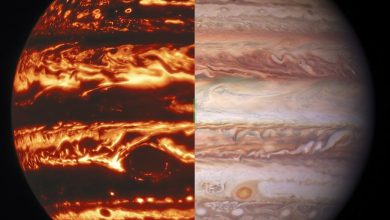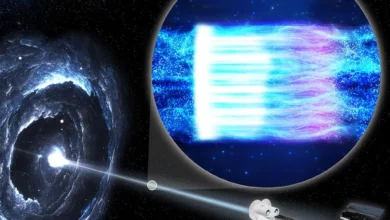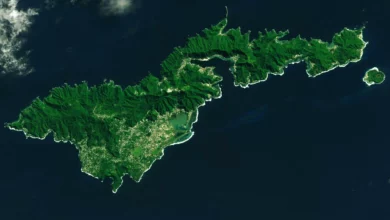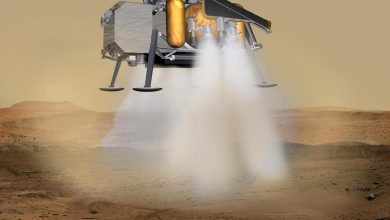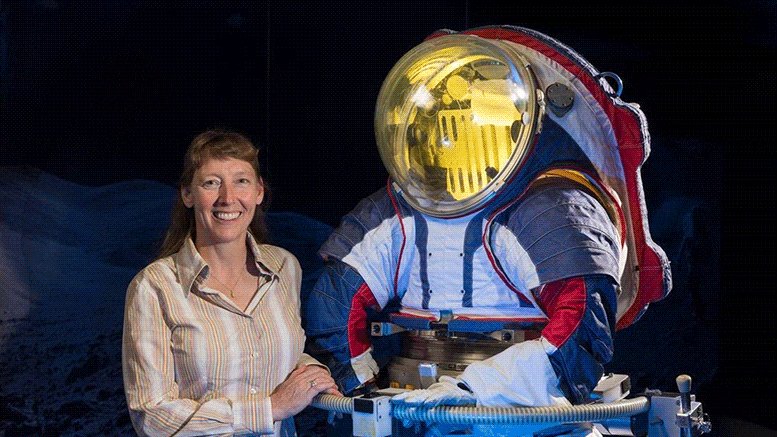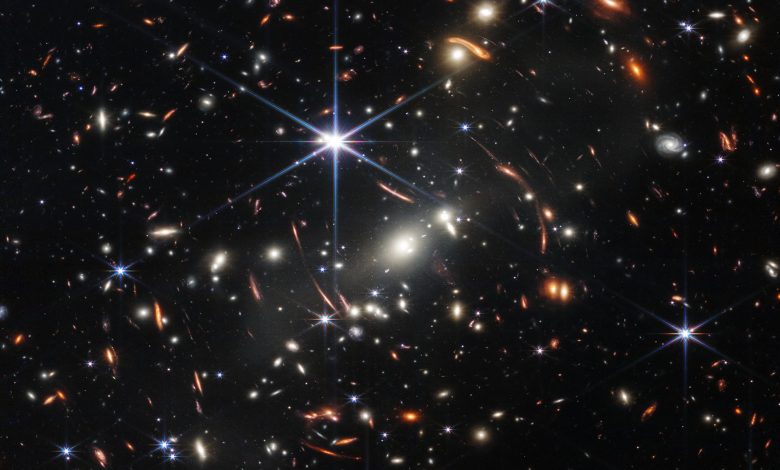
Lead Image: The NASA/ESA/CSA James Webb Space Telescope has produced the deepest and sharpest infrared image of the distant Universe to date. Known as Webb’s First Deep Field, this image of galaxy cluster SMACS 0723 is overflowing with detail. Thousands of galaxies flood this finely detailed image, due to high-resolution imaging from NASA’s James Webb Space Telescope combined with a natural effect known as gravitational lensing. Credit: NASA, ESA, CSA, and STScI
Exquisite New Data Will Transform Our Understanding of the Early Universe
A flurry of bright white galaxies is stirring up this incredible scene – captured in stunning high resolution by NASA’s James Webb Space Telescope. Known as galaxy cluster SMACS 0723, the group of galaxies is also bending and warping the light from more distant galaxies behind them, stretching and repeating their appearances. Webb’s near- and mid-infrared imaging – and highly detailed data known as spectra – will allow researchers in the future to finely catalog the precise compositions of galaxies in the early universe, which may ultimately reshape our understanding of how galaxies changed and evolved over billions of years.
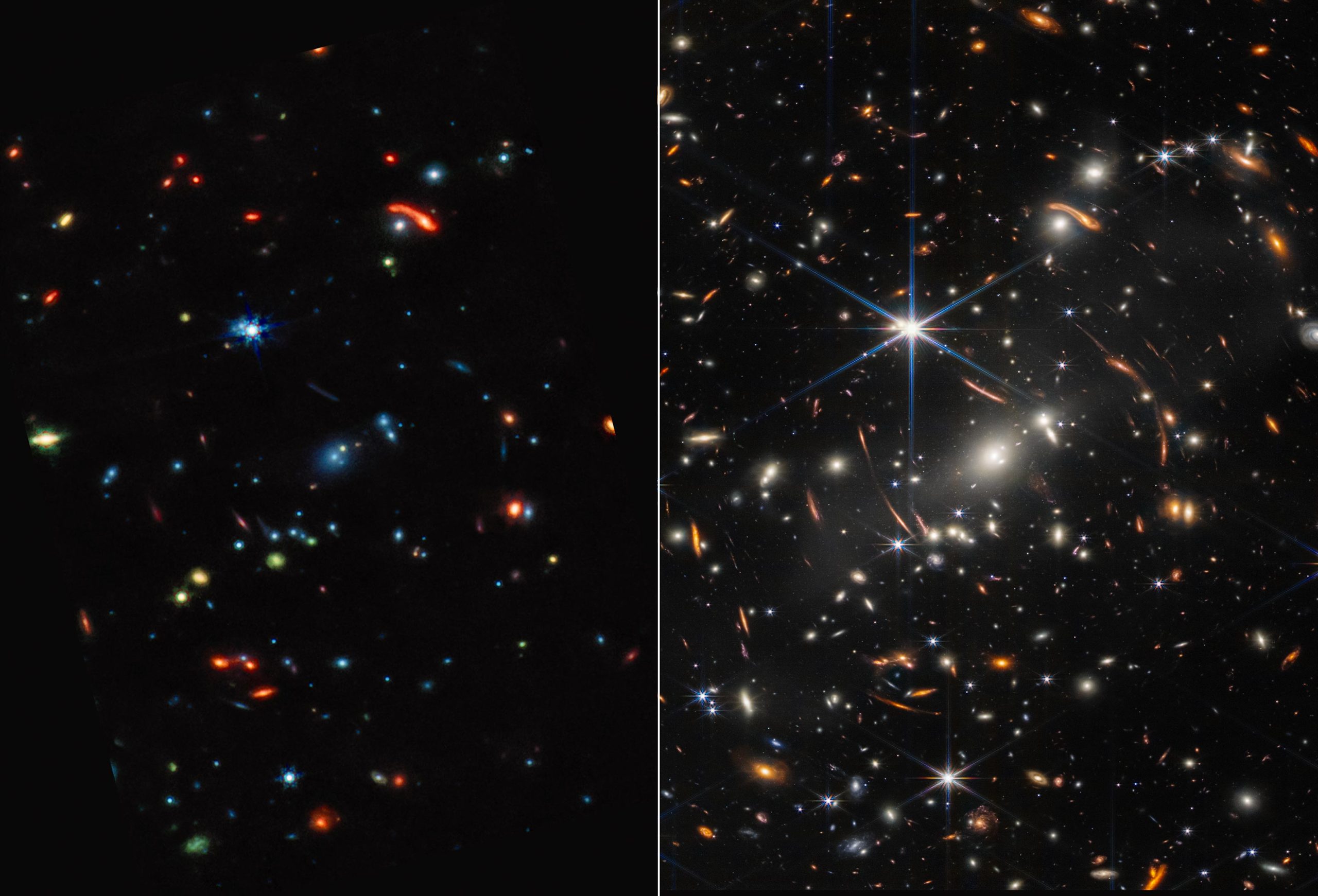
Start by comparing the largest bright blue star. At right, it has very long diffraction spikes, but in mid-infrared at left, its smaller points appear more like a snowflake’s. Find more stars by looking for these telltale – if tiny – spikes. Stars also appear yellow, sometimes with green diffraction spikes.
If an object is blue and lacks spikes, it’s a galaxy. These galaxies contain stars, but very little dust. This means that their stars are older – there is less gas and dust available to condense to form new stars. It also means their stars are aging.
The red objects in this field are enshrouded in thick layers of dust, and may very well be distant galaxies. Some may be stars, but research is needed to fully identify each object in the mid-infrared image.
The prominent arcs at the center of the galaxy cluster, which are galaxies that are stretched and magnified by gravitational lensing, appear blue in the Mid-Infrared Instrument (MIRI) image at left and orange in the Near-Infrared Camera (NIRCam) image at right. These galaxies are older and have much less dust.
Galaxies’ sizes in both images offer clues as to how distant they may be – the smaller the object, the more distant it is. In mid-infrared light, galaxies that are closer appear whiter.
Among this kaleidoscope of colors in the MIRI image, green is the most tantalizing. Green indicates a galaxy’s dust includes a mix of hydrocarbons and other chemical compounds.
The differences in Webb’s images are owed to the technical capabilities of the MIRI and NIRCam instruments. MIRI captures mid-infrared light, which highlights where the dust is. Dust is a major ingredient for star formation. Stars are brighter at shorter wavelengths, which is why they appear with prominent diffraction spikes in the NIRCam image.
With Webb’s mid-infrared data, researchers will soon be able to add much more precise calculations of dust quantities in stars and galaxies to their models, and begin to more clearly understand how galaxies at any distance form and change over time.
Credit: NASA, ESA, CSA, STScI
NASA’s Webb Space Telescope Delivers Deepest Image of Universe Yet
NASA’s James Webb Space Telescope has delivered the deepest and sharpest infrared image of the distant universe so far. Affectionately known as Webb’s First Deep Field, this is galaxy cluster SMACS 0723 and it is teeming with thousands of galaxies – including the smallest, faintest objects ever observed.
Webb’s image is approximately the size of a grain of sand held at arm’s length, a tiny sliver of the vast universe. The combined mass of this galaxy cluster acts as a gravitational lens, magnifying more distant galaxies, including some seen when the universe was less than a billion years old. This deep field, taken by Webb’s Near-Infrared Camera (NIRCam), is a composite made from images at different wavelengths, totaling 12.5 hours – achieving depths at infrared wavelengths beyond the Hubble Space Telescope’s deepest fields, which took weeks. And this is only the beginning. Researchers will continue to use Webb to take longer exposures, revealing more of our vast universe.

At far left is a near-infrared image of galaxy cluster SMACS 0723. A group of massive galaxies below and to the right of the bright central star have distorted, magnified, and mirrored many galaxies in this field.
By quickly examining the image at left by eye, it becomes clearer that one arc may be made up of two similar-looking galaxies. Their bright central regions match, despite their stretched appearances. These may be lensed galaxies – one galaxy that is mirrored in a second location. Are they the same? Researchers can’t be sure from the image alone – more data are needed to confirm a match.
Scientists do this by gathering spectra, which spread light out so they can fully examine an object’s makeup. Webb’s Near-Infrared Imager and Slitless Spectrograph (NIRISS), which gathers spectra of every object in any field it observes, was pointed at the galaxy cluster to gather more detail. A segment of the NIRISS grism image (an instrument that has a grating, or stair steps, on a prism), at center, shows how ionized oxygen and atomic hydrogen emission lines are distributed along the arc.
Next, the spectra from each of these two galaxies were plotted as graphs, shown at right, to reveal their compositions. The graphs, known as spectra, match, which indicates that these arcs are mirror images of the same galaxy. Webb’s spectra from NIRISS also quickly proved that light from both galaxies was emitted 9.3 billion years ago, further confirming they are one and the same.
Using Webb’s NIRISS is like opening a treasure chest overflowing with spectra. For example, this instrument can disperse the spectra along the image vertically and horizontally. Researchers can use both modes to untangle which lines match each source.
Every object’s image can be transformed into spectra like the two shown above. So even if researchers aren’t intending to study a particular galaxy in the field, they may make a surprise discovery.
Credit: NASA, ESA, CSA, STScI
This image shows the galaxy cluster SMACS 0723 as it appeared 4.6 billion years ago, with many more galaxies in front of and behind the cluster. Much more about this cluster will be revealed as researchers begin digging into Webb’s data. This field was also imaged by Webb’s Mid-Infrared Instrument (MIRI), which observes mid-infrared light.
Webb’s NIRCam has brought distant galaxies into sharp focus – they have tiny, faint structures that have never been seen before, including star clusters and diffuse features.
Light from these galaxies took billions of years to reach us. We are looking back in time to within a billion years after the big bang when viewing the youngest galaxies in this field. The light was stretched by the expansion of the universe to infrared wavelengths that Webb was designed to observe. Researchers will soon begin to learn more about the galaxies’ masses, ages, histories, and compositions.

Of the thousands of distant galaxies behind galaxy cluster SMACS 0723, NIRSpec observed 48 individually – all at the same time – in a field that is approximately the size of a grain of sand held at arm’s length. Quick analysis made it immediately clear that several of these galaxies were observed as they existed at very early periods in the history of the universe, which is estimated to be 13.8 billion years old.
Look for the same feature highlighted in each spectrum. Three lines appear in the same order every time – one hydrogen line followed by two ionized oxygen lines. Where this pattern falls on each spectrum tells researchers the redshift of individual galaxies, revealing how long ago their light was emitted.
Light from the farthest galaxy shown traveled 13.1 billion years before Webb’s mirrors captured it. These observations mark the first time these particular emission lines have been seen at such immense distances – and these are only Webb’s initial observations. There may be even more distant galaxies in this image!
In these spectra, Webb has also shown us the chemical composition of galaxies in the very early universe for the first time. This was made possible by the telescope’s position in space – far away from Earth’s atmosphere, which filters out some infrared light – and its specialization in gathering high-resolution near-infrared light.
And since similar spectra from galaxies at closer distances have long been studied by other space- and ground-based observatories, astronomers already know a lot about the properties of nearby galaxies. Now, astronomers will be able to study and compare spectra from Webb to determine how galaxies have changed over billions of years, dating back to the early universe.
With Webb’s data, researchers can now measure each galaxy’s distance, temperature, gas density, and chemical composition. We will soon learn an incredible amount about galaxies that existed all across cosmic time!
Want to capture your own spectra with Webb’s microshutter array? Learn how scientists use the instrument by “taking” your own observations with this interactive and analyze the spectra it returns.
Credit: NASA, ESA, CSA, STScI
Other features include the prominent arcs in this field. The powerful gravitational field of a galaxy cluster can bend the light rays from more distant galaxies behind it, just as a magnifying glass bends and warps images. Stars are also captured with prominent diffraction spikes, as they appear brighter at shorter wavelengths.
Webb’s MIRI image offers a kaleidoscope of colors and highlights where the dust is – a major ingredient for star formation, and ultimately life itself. Blue galaxies contain stars, but very little dust. The red objects in this field are enshrouded in thick layers of dust. Green galaxies are populated with hydrocarbons and other chemical compounds. Researchers will be able to use data like these to understand how galaxies form, grow, and merge with each other, and in some cases why they stop forming stars altogether.
In addition to taking images, two of Webb’s instruments also obtained spectra – data that reveal objects’ physical and chemical properties that will help researchers identify many more details about distant galaxies in this field. Webb’s Near Infrared Spectrograph (NIRSpec) microshutter array observed 48 individual galaxies at the same time – a new technology used for the first time in space – returning a full suite of details about each. The data revealed light from one galaxy that traveled for 13.1 billion years before Webb’s mirrors captured it. NIRSpec data also demonstrate how detailed galaxy spectra will be with Webb observations.
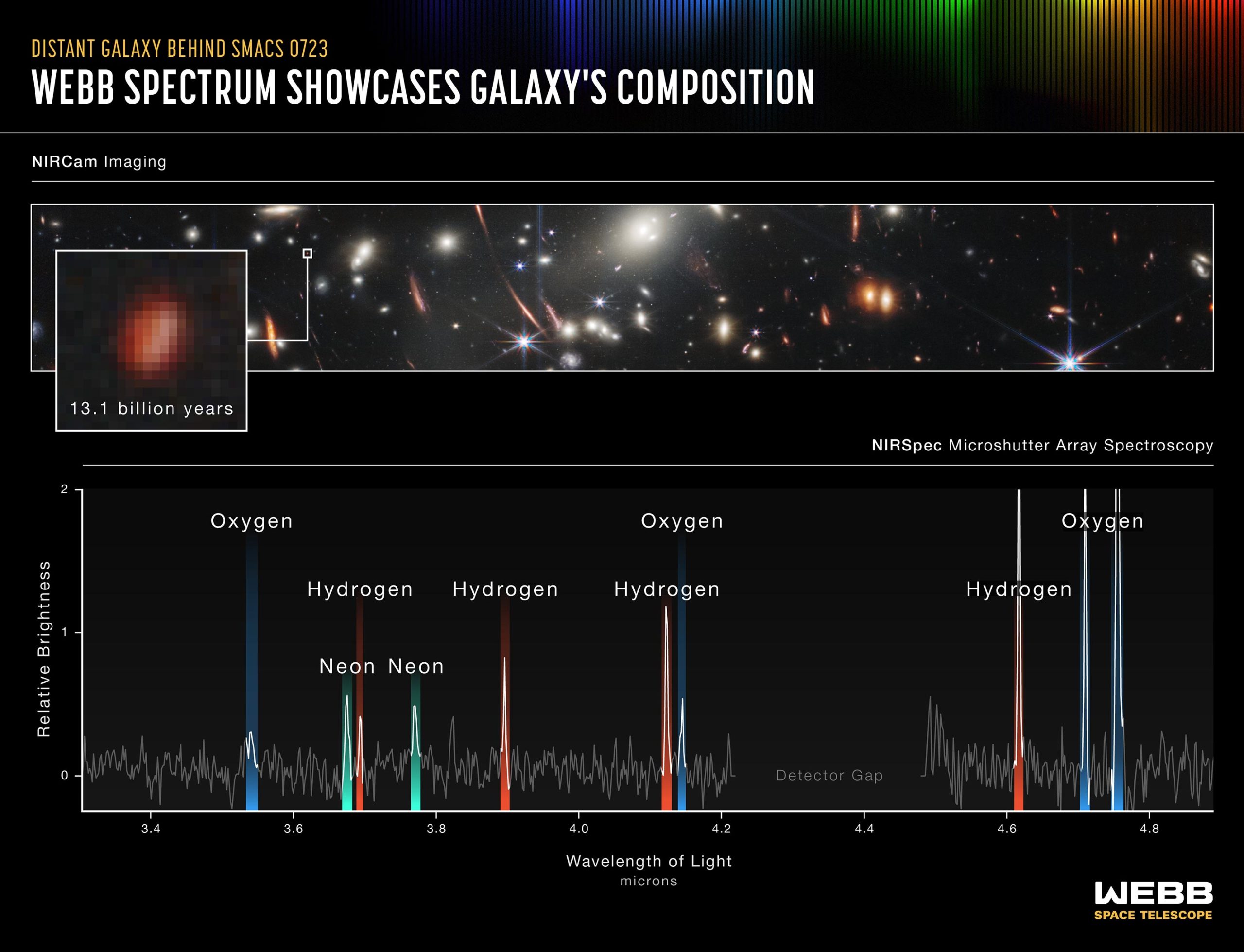
It was captured by Webb’s microshutter array, part of its Near-Infrared Spectrograph (NIRSpec). This instrument is so sensitive that it can observe the light of individual galaxies that existed in the very early universe. This will prove transformational for research. Webb’s capabilities have allowed scientists to observe spectra of galaxies this far away for the first time.
When researchers stretch out the light of an individual galaxy into a spectrum, like the graph shown above, they can learn about the chemical composition, temperature, and density of the galaxy’s ionized gas. For example, this galaxy’s spectrum will reveal the properties of its gas, which will indicate how its stars are forming and how much dust it contains. These data are rich – and have never before been detected from this far away at this quality.
As astronomers begin analyzing Webb’s data, we will learn an incredible amount about galaxies that existed all across cosmic time – and how they compare to the beautiful spiral and elliptical galaxies in the nearby universe.
Want to capture your own spectra with Webb’s microshutter array? Learn how scientists use the instrument by “taking” your own observations in this interactive and analyze the spectra it returns.
For a full array of Webb’s first images and spectra, including downloadable files, please visit: https://webbtelescope.org/news/first-images
NIRSpec was built for the European Space Agency (ESA) by a consortium of European companies led by Airbus Defence and Space (ADS) with NASA’s Goddard Space Flight Center providing its detector and micro-shutter subsystems.
Credit: NASA, ESA, CSA, STScI
Finally, Webb’s Near-Infrared Imager and Slitless Spectrograph (NIRISS) used Wide-Field Slitless Spectroscopy to capture spectra of all the objects in the entire field of view at once. Among the results, it proves that one of the galaxies has a mirror image.
SMACS 0723 can be viewed near the constellation Volans in the southern sky.
The James Webb Space Telescope is the world’s premier space science observatory. Webb will solve mysteries in our solar system, look beyond to distant worlds around other stars, and probe the mysterious structures and origins of our universe and our place in it. Webb is an international program led by NASA with its partners, ESA (European Space Agency) and CSA (Canadian Space Agency).
NASA Headquarters oversees the mission for the agency’s Science Mission Directorate. NASA’s Goddard Space Flight Center in Greenbelt, Maryland, manages Webb for the agency and oversees work on the mission performed by the Space Telescope Science Institute, Northrop Grumman, and other mission partners. In addition to Goddard, several NASA centers contributed to the project, including the agency’s Johnson Space Center in Houston, Jet Propulsion Laboratory (JPL) in Southern California, Marshall Space Flight Center in Huntsville, Alabama, Ames Research Center in California’s Silicon Valley, and others.
NIRCam was built by a team at the University of Arizona and Lockheed Martin’s Advanced Technology Center.
MIRI was contributed by ESA and NASA, with the instrument designed and built by a consortium of nationally funded European Institutes (the MIRI European Consortium) in partnership with JPL and the University of Arizona.
NIRSpec was built for ESA by a consortium of European companies led by Airbus Defence and Space (ADS) with NASA’s Goddard Space Flight Center providing its detector and micro-shutter subsystems.
NIRISS was contributed by CSA. The instrument was designed and built by Honeywell in collaboration with the Université de Montréal and the National Research Council Canada.

